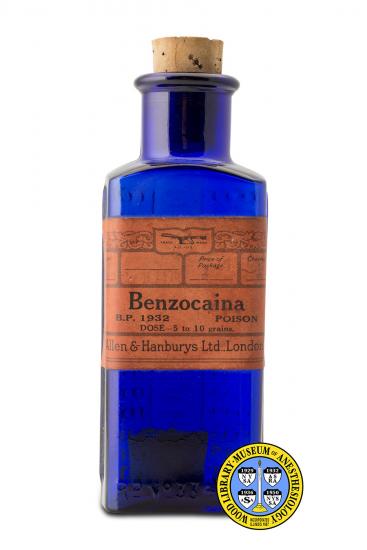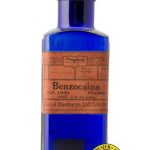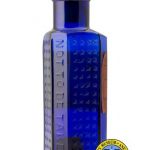Benzocaine
German chemist Eduard Ritsert (1859-1946) was one of many who joined in the search for a non-addictive substitute for cocaine. In 1900, he synthesized benzocaine, a derivative of the organic compound para-aminobenzoic acid (PABA). Two years later, he introduced benzocaine under the name “Anaesthesin” (also called Anesthesine). In 1903 he patented his formula, and founded a company to manufacture and sell it. Benzocaine is a weak local anesthetic and has been used primarily as an external pain reliever. It is an ingredient in numerous commercial products for application on the skin, as well as in the ears, and mouth. The “Benzocaina” brand was made by the English pharmaceutical and surgical equipment maker, Allen & Hanburys. The use of benzocaine in topical analgesics has declined because, like the PABA from which it is derived, it can cause allergic reactions.
Catalog Record: Benzocaine
Access Key: aldw
Accession No.: 2003-03-09-1
Title: Benzocaina / Allen & Hanburys Ltd.
Corporate Author: Allen & Hanburys Ltd.
Title variation: Alt Title
Title: Benzocaine.
Publisher: London : Allen & Hanburys Ltd., [between] 1932 [and 1948?].
Physical Descript: 1 bottle : glass, cork, paper ; 13.5 x 5 x 3.5 cm.
Subject: Benzocaine.
Subject: Anesthetics, Local – history.
Subject: Drug Packaging.
Note Type: General
Notes: The early year (1932) for the date range for the possible year of manufacture
is based on the British Pharmacopæia date printed on the label (“B.P. 1932”).
The end date for the possible year of manufacture is based on the publication
date of the next edition of the British Pharmacopæia (1948). The bottle may
have been manufactured a number of years before the label, and the benzocaine
that once was held in the bottle. It is possible that the label on this
bottle was removed from a different bottle or container and placed on this
bottle. The date range could change if documentation that indicates the dates
should be corrected is discovered.
Note Type: Citation
Notes: Cope Z. Allen and Hanburys, 1715–1954. British Medical Journal. February 5,
1955;1(4909):337. https://www.ncbi.nlm.nih.gov/pmc/articles/PMC2060881/.
Accessed September 24, 2014.
Note Type: Citation
Notes: General Medical Council. The British Pharmacopaeia, 1932. [6th ed.] London:
Constable, 1932.
Note Type: Citation
Notes: General Medical Council. The British Pharmacopeia, 1948. [7th ed.] London:
Constable, 1949.
Note Type: Citation
Notes: Marriott JF, Wilson KA, Langley CA, Belcher D. History of compounding. In:
Pharmaceutical Compounding and Dispensing. London: Pharmaceutical Press,
2010:13-14.
Note Type: Physical Description
Notes: One blue glass medicine bottle with an irregular shape; A cork is inside the
bottle; Another cork is in the top of the bottle; With the cork the bottle
measures approximately 13.4 x 4.8 x 3.3 cm (height x width x depth). Without
the cork the bottle measures approximately 12.5 cm in height; The front is
flat; The sides and the back are roughly the shape of half of an octagon;
The words “NOT TO BE TAKEN” are embossed along the central plane of the back;
The planes, on either side of the back center plane, are embossed with rows
of crosses; Prominent seams join the planes on each side of the front to the
back of the bottle; A number three is embossed on the bottom of the bottle;
The bottle may have been manufactured a number of years before the label, and
the benzocaine that once was held in the bottle; Based on the appearance of
the label and adhesive around the label, it is possible that the label is not
original to this bottle; The label is brown and includes a number of
manufacturer markings; Along the upper portion of the label handwritten
information under the following markings is no longer readable: “Weight”,
“Price of Package”, “Checked by”; Other markings, from top to bottom, include
“Benzocaina [new line] B.P. 1932 POISON [new line] DOSE-5 to 10 grains.
[new line] Allen & Hanburys Ltd., London.”
Note Type: Reproduction
Notes: Photographed by Mr. Steve Donisch, February 11, 2014.
Note Type: Historical
Notes: German chemist Eduard Ritsert (1859-1946) was one of many who joined in the
search for a non-addictive substitute for cocaine. In 1900, he synthesized
benzocaine, a derivative of the organic compound para-aminobenzoic acid
(PABA). Two years later, he introduced benzocaine under the name
“Anaesthesin” (also called Anesthesine). In 1903 he patented his formula, and
founded a company to manufacture and sell it. Benzocaine is a weak local
anesthetic and has been used primarily as an external pain reliever. It is an
ingredient in numerous commercial products for application on the skin, as
well as in the ears, and mouth. The “Benzocaina” brand was made by the
English pharmaceutical and surgical equipment maker, Allen & Hanburys. The
use of benzocaine in topical analgesics has declined because, like the PABA
from which it is derived, it can cause allergic reactions.
Note Type: Exhibition
Notes: Selected for the WLM website.



